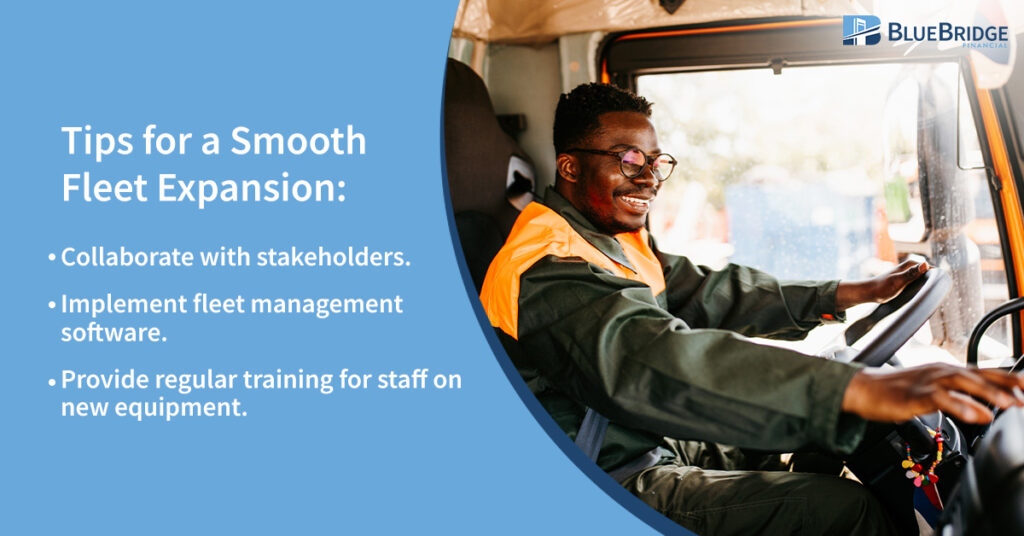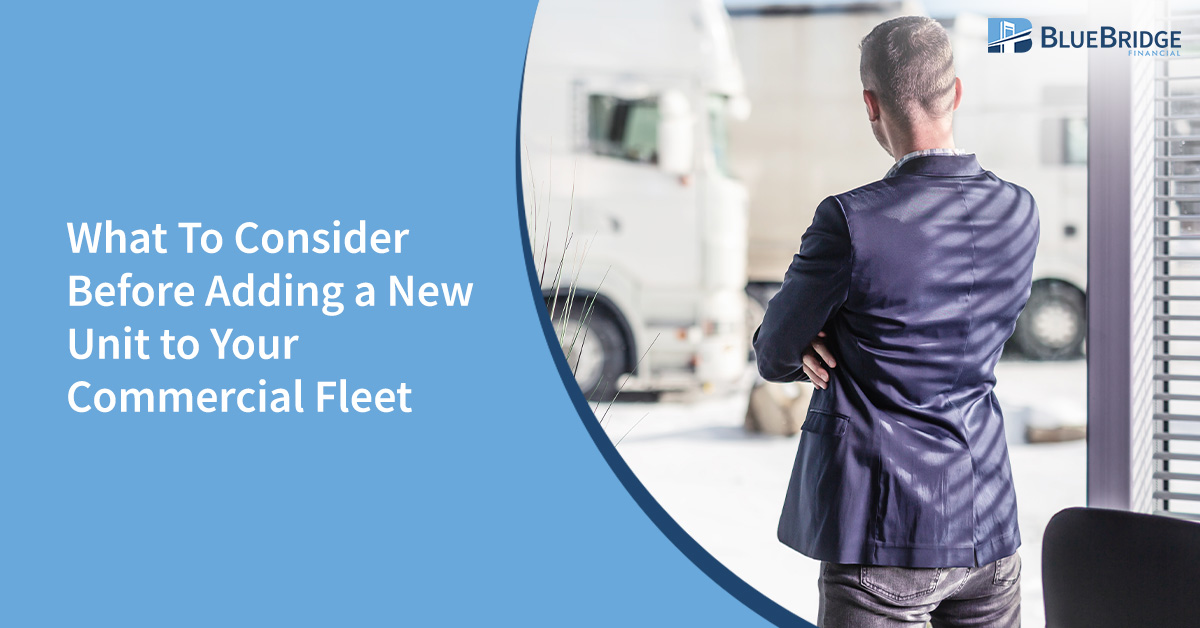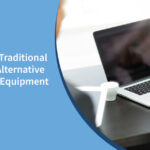What To Consider Before Adding a New Unit to Your Commercial Fleet
Grow Your Fleet with Confidence: What to Know Before Adding a New Unit
As a business owner or operations manager, you’ve reached the point where you need to expand your commercial fleet. Adding trucks, vans, or more specialized vehicles to your fleet can bring a variety of benefits to your business. It helps you scale your operation, for one thing, and can increase productivity. However, there are several important factors to consider before adding to your fleet. From ROI to your financing options and more, keep reading for everything you need to consider and how to choose the right new unit for your commercial fleet.
Is now the right time for fleet expansion?
Making the decision to expand your commercial fleet isn’t just about the number of units you need. It’s also a calculation of how many units you can safely and affordably manage given your current staff and financial resources. If you expand too soon, you could end up tanking your cash flow with additional expenses you can’t comfortably afford yet. But if you wait too long, you could end up missing out on new customers and other growth opportunities. Here are the most important factors that go into fleet expansion decisions:
Business Efficiency
This refers to the effectiveness with which you deliver products or provide services to your customers, compared to the time and cost required to do so. Successful businesses find the efficiency “sweet spot” between the labor, materials, and capital needed to operate, and the profit that flows back from that investment of resources.
Of course, each new unit you add will come with certain expenses, such as new hires and/or insurance and maintenance costs. But you may also be able to reduce certain costs with a strategic equipment purchase. For example, adding an electric vehicle to your fleet will reduce your spending on fuel.
Growth Opportunities
It takes money to make money, as the saying goes. Expanding your fleet could help your business capture additional revenue from existing (and unmet) demand in your local market. You may also be anticipating and preparing for future growth opportunities.
The State of Your Current Fleet
Whether or not you decide to expand right now, it’s a good practice to regularly evaluate your current fleet’s efficiency and identify areas of improvement. This will help you decide when to add new units, as well as when to replace older ones, reducing obsolescence.
How To Choose the Right Addition To Your Fleet
If you’ve decided it’s time to expand, your next decision is which new vehicle or piece of equipment to choose. Sometimes you just want to replace or buy more of what you already have. But other times you may be looking for an upgrade to take on new projects or better align with your services. Environmental concerns may also factor into your decision. Not only will an electric vehicle help you save on fuel costs–you can also make your environmentally-friendly fleet part of your marketing and branding.

Cost-Benefit and ABC Analysis
Calculating ROI is an important part of adding a new unit. You need to consider both direct costs, such as purchase price and maintenance, as well as indirect benefits such as increased revenue and improved service time.
Use the ABC Analysis to decide on fleet additions based on importance and impact on operations:
A. The units that fall into this category should be your top priority when considering additional equipment for your business. For example, a dump truck for a construction business. Your ‘A’ units are those that are both crucial to your operation and have the potential to produce the highest returns in both revenue and operational efficiency; thus, being the most important to your success.
B. Once you have secured your essential pieces, it may be time to consider adding a ‘B’ unit to your business. These are pieces of equipment that may not be essential to your day-to-day operations, but they can provide significant additional value. An example of a this is a restaurant adding a van to their delivery fleet. Not only does adding this unit increase overall efficiency and capacity of the existing fleet and deliveries, but it also opens the opportunity to offer catering services, a whole new stream of revenue. While these units may not be top priority, they enable a business to be flexible and diverse in their offerings.
C. Finally, we have the units that are not necessary for your business. The ‘C’ level units include things that may be on your long term ‘wish-list’ but are not necessary for success today or in the near future. Additionally, this category includes equipment that you may need to achieve one specific goal or job. For example, a farmer may add specialized harvesting equipment to his or her operation once a year to harvest a particular crop. This is the type of equipment that may be better off leased or rented on an ‘as-needed’ basis, opposed to making a long-term investment through a loan.
This dual analysis of ROI and ABC can help guarantee that your investments in your fleet are directed towards units that yield high returns and support operational priorities.
Maintenance and Warranties
Regular maintenance of your fleet will help extend the lifespan of each unit, in addition to helping prevent major repairs. With each new unit you add, you need to budget for routine maintenance as well as save for bigger repairs. How easily can your current maintenance regimen be scaled to meet the needs of your growing fleet? Depending on the size of your fleet, you may be able to save money and gain convenience through a service contract, as well as extended warranties on individual units.

Insurance and Liability
Along with budgeting for maintenance and possibly extended warranties, you also need to review your insurance options and needs. What are the liability implications of adding new units? Talk with your current insurer and consider getting quotes from other insurance companies to find the best coverage.
Explore Financing Options
When it comes to financing the purchase of new units for your commercial fleet, you have a variety of options. Banks, specialty equipment finance firms like Blue Bridge, and other lenders offer business and business equipment loans.
What do specialty equipment finance firms offer?
In contrast to banks, which offer a variety of loans and other financial products, specialty equipment finance firms focus just on making equipment loans. This allows firms like Blue Bridge to fill a gap in the lending market–in our case, to enable businesses to finance equipment more quickly. Our simplified application and approval process can get you the funding you need within 24 hours. Banks simply can’t move that fast.
What are the different types of equipment loans?
Understand your options for financing commercial fleet expansion.
- Equipment Finance Agreement (EFA): This is the most popular type of financing we offer. EFAs are a great alternative to a traditional bank loan because you don’t need to put much or any money down. This allows you to quickly expand your commercial fleet without tying up a huge amount of cash.
- Working Capital: This is an add-on to your existing EFA approval. Up to $50,000 in working capital can be added as a second agreement with monthly payments, expanded terms, and lower-than-average interest rates.
- Rental Inventory: Inventory financing for rental equipment comes with the same terms as a standard EFA product.
Benefits of Secured Loans
- Preserve cash flow, avoid draining your savings, and free up cash for other needs
- Flexible repayment terms to fit your needs and budget
- Quick loan approvals, usually within 4 hours
- Competitive rates
- 100% financing available
- Tailored equipment financing solutions from experts in the field

Tips for a Smooth Fleet Expansion
Follow these tips to ensure a smooth fleet expansion process.
- Collaborate with stakeholders (drivers, maintenance teams, etc.).
- Implement fleet management software for tracking vehicles, scheduling maintenance, and ensuring efficiency; this can also help reduce costs by minimizing manual work.
- Provide regular training for staff on new equipment.
About Blue Bridge Financial
We are your equipment financing expert, having funded over 9,000 businesses in 30+ industries. We can fund your business, too! Our flexible loan programs and competitive rates are tailored to your needs. There are no age or mileage restrictions and we work with private party sellers. Get your funds fast with same-day loan approvals. Strapped for cash but need equipment now? You can defer your loan payments for 90 days with our deferred payments program.
Expanding your commercial fleet is an exciting sign of your business’s success. At Blue Bridge Financial, we know that one size doesn’t fit all. We can customize an equipment loan to meet your financing needs. Contact us today!
Any Questions? We'd Love to Talk:
About the Author
Nick Devernis is the Vice President of Business Development with expertise in credit analysis and equipment financing. With over 6 years in equipment financing, he offers a wealth of knowledge to readers of Blue Bridge Financial’s blog. He currently oversees the California office and leads the Sales and Marketing departments. Nick’s role as Vice President of Business Development involves management of the sales team, relationship management, and developing strategic partnerships to drive inbound and outbound originations.p> LinkedIn Profile






